|
|
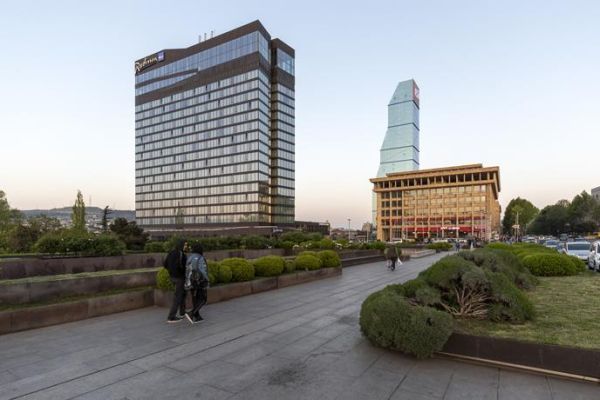 |
| |
Radisson Blu Iveria Hotel, 2008, Graft Architects & The Biltmore
Hotel, 2016, unknown architect. The vacant building in between
is currently being rebuilt as a hotel extension with casino.
Photo
© Erik-Jan Ouwerkerk
|
Together with renowned Georgians, the various
levels of this contradictory city are explored at a particular
stage of a transformation that oscillates geographically and
intellectually between Europa, Russia, Turkey and the Arab
states, between East and West, between the 19th century, the
Soviet Union, and an optimistic 21st century. With its feverish
urban construction activity and its wild night life, the city is
attracting international attention.
Almost forgotten, palaces, administrative buildings, churches,
and museums built by European architects in the 19th century are
falling into disrepair. Next to them stand Soviet-era structures
attesting to Stalinist and Constructivist trends, and even hyper
late-Soviet formal experiments, such as the Ministry of Highway
Construction, a true icon of Soviet Brutalism. In the transition
period thereafter, self-built, life-threatening “kamikaze
loggias” proliferated on pre-fabricated buildings. Later on,
with a new Messiah as president, entire streets were
reconstructed, spectacular newbuilds signaling a bright new
future. Today, in the era that followed, it is the private
investors who rule, building on a grandiose scale. Tbilisi, the
small Caucasian would be European.
City Walk – Collages on the Kura
In Tbilisi, you quickly find it nigh impossible to track down
something that constitutes “typical Georgian architecture.” The
appearance of the built environment in the city on the banks of
the Kura River is too heterogeneous and contradictory for that.
In addition to the medieval churches and the old town with its
Oriental influences not to mention the Historicist quarters
south of the Kura, one can find almost every significant
architectural style of the last 150 years in its original
condition in Tbilisi – making the city an inexhaustible trove
for travelers with an interest in architecture.
|
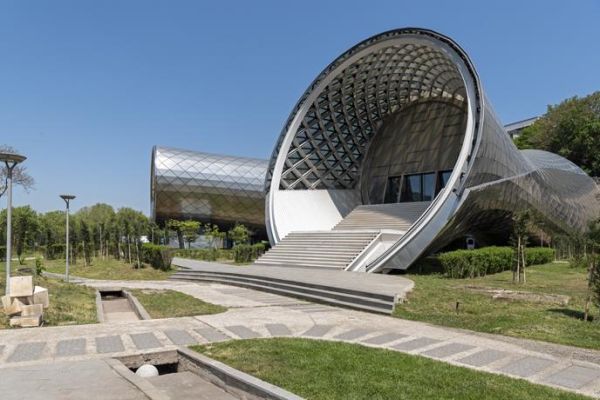 |
|
|
Concert and Exhibition Hall, 2011, Massimiliano and
Doriana Fuksas,
Photo
© Erik-Jan Ouwerkerk
|
|
Modern boutique hotels opposite decaying Art Nouveau buildings,
improvised single-family homes behind new apartment towers,
abandoned vast parking garages from the Soviet era – there are
just a few of the endless possibilities to discover something
new around every corner. Yet a glance at the details also
reveals a cosmos of its own time and again. There are plenty of
surprises in store behind historical front doors. The ubiquitous
will to create something individual, which one can discern among
the residents, is particularly impressive. No two buildings are
alike, and there are no uniform appearances or colors – possibly
an obvious reaction to the decades of Soviet socialist urban
planning for the new man that still characterizes the city’s
peripheral districts to this day.
|
|
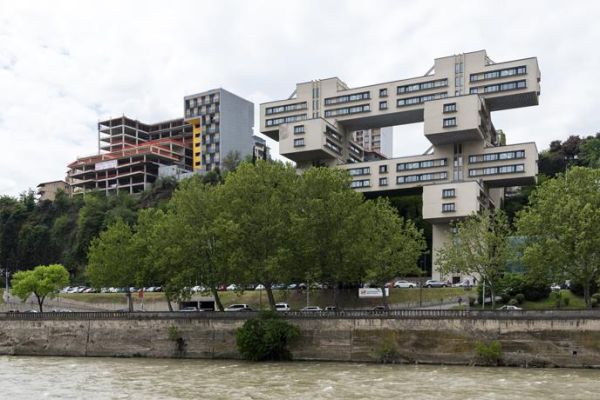 |
| |
The
famous Soviet Ministry of Highway Construction, 1975 by George
Chakhava, now the headquarters of the Bank of Georgia. Photo
© Erik-Jan Ouwerkerk
|
Large/small, old/new, spacious/compact, rich/poor, tall/low,
straight/slanted, modern/historical, steep/flat, colorful/gray –
these are not pairs of opposites, but adjectives that describe
the buzzing, fascinating and eclectic impression that Tbilisi
makes on its visitors. Hybrid Tbilisi, indeed
The historical,
political and building developement of Tblisi
The history of Tbilisi until 1920 Legend has it that King
Vakhtang Gorgasali came hunting in the area and shot a
pheasant.The bird fell into a hot spring and was boiled.
Thereupon, the king decreed that on the spot a town be built,
which he named “Tbilisi”, meaning “warm” in Georgian. This
occurred in the year 458 CE. Tbilisi has had a town charter ever
since, and in the late 5th century became the capital of the
east Georgian kingdom.
|
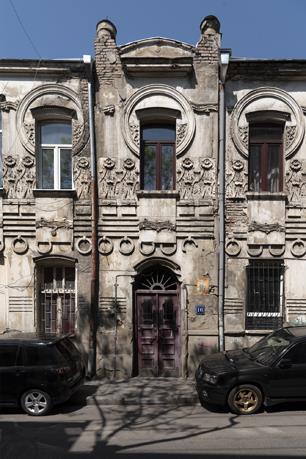 |
|
|
Neglected downtown art
nouveau villas were often built by Central and Northern
European architects,
Photo
© Erik-Jan Ouwerkerk |
|
Tbilisi has experienced much suffering in its eventful history –
alongside Armenia, Georgia is an enclave of Christianity in a
part of the world dominated by Islam. For centuries it was
pillaged and burnt to the ground by belligerent neighbors. From
the 6th to the 11th century these were the Sassanids, Byzantines,
Arabs and Seljuks. The 12th century became Georgia’s “Golden Era”.
From the 14th to the 18th century the country was laid waste in
forays by the Mongols, Ottomans, and Safavids. This is why there
are no civil buildings built before 1790 left standing in
Tbilisi.
In its need, in the 18th century the Georgian nation sought
protection from its powerful Christian neighbor Russia. In 1801,
the Georgian kingdom was incorporated into the Russian Empire –
Tbilisi became the capital of the Caucasian protectorate. Hotels
and banks replaced the old residences and caravanserais. Baroque
merchants’ villas were built ever higher up the slopes of
Sololaki Hill. After the collapse of the Russian Empire in 1917
Georgia declared its independence on May 26, 1918.
Early Soviet era: 1920 until 1955
Four years after the October Revolution, on February 25, 1921,
the Red Army invaded Georgia and brought the country’s
independence to an end. The country was initially declared the
Transcaucasian Socialist Federative Republic, and in 1936 a
Republic of the Soviet Union. Soviet ideology introduced a trend
towards monumental structures and the combatting of
individuality to construction policy. Under the Bolshevist
leader Lavrentiy Beria the city underwent unprecedented
“modernization” in the 1930s. The newspaper building “Zarya
Vostoka”, which was built in the Constructivist style, the upper
station of the Funicular, and the edifice housing the Marx
Engels Lenin Institute are among the few remaining examples of
this decade. Befo- re World War II, there was a boom in housing
construction in Tbilisi. The residential buildings down- town
and on Marjanishvili Square, which were built in the “Stalin
Empire style”, the Georgian National Academy of Sciences, and
the Presidential Palace are the prime examples of post-War
architecture. In the 1950s, apartment buildings were the most
widespread feature.
Late Soviet era:1955 until 1990 In 1956, a war on “superfluous
decoration” was declared. The Khrushchev era was characterized a
radical revision of local architecture and its aesthetic
principles. Architects endeavored to find original solutions,
and new materials and technologies. Construction corporations
were founded with a view to enabling the swift mass production
of residential buildings. Quality standards with regard to
construction took a back seat to quantity. Despite Brezhnev’s
“Era of Stagnation”, given the trends towards expressive mega-
structures the most interesting era was probably that between
1964 and 1982. Spectacular edifices were built: Georgia’s most
famous building, the Ministry of Highway Construction, the Hotel
Iveria, the Philharmonic and the new State University. According
to the 1970 master plan, Tbilisi was intended to grow to a size
of 1.2 million inhabitants. Hectic achievement of the objectives
through the construction of satellite settlements led to
uncontrolled growth and today’s problems on the city’s outskirts.
Only a few extraordinary buildings such as the church-like
“Wedding Palace” and the Archaeological Museum date from the
1980s.
|
|
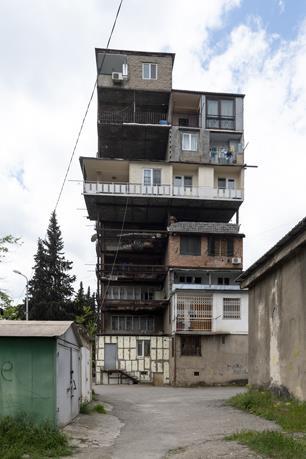 |
| |
"Kamikaze loggias" were called the illegally grown extensions.
Photo
© Erik-Jan Ouwerkerk
|
The period of transition: 1990 until 2003 The late 1980s, when
the Soviet Union was breaking up, saw the beginning of Georgia’s
most difficult period. Demonstrations and rallies were part of
everyday life. Rustaveli Avenue became the place for political
ambitions and euphoric passion. On April 9, 1991, on the basis
of a referendum, formally announced its exit from the USSR and
the independence of the Republic of Georgia. At the turn of the
year 1991-92 there were civil war-like conflicts in Tbilisi.
What was known as the “Christmas War” between supporters of
President Zviad Gamsakhurdia and the National Guard lasted
almost two weeks. As a consequence of the dramatic events the
reconstruction of Rustaveli Avenue and Freedom Square was due,
an enormous challenge for Georgian architects. Following the
declaration of independence, urban development has been
dominated by the mechanisms of private investors and a market
economy. Municipal apartments were transferred to the tenants as
private property, extensions were added without planning
permission, the so-called “kamikaze loggias”. The authorities no
longer conducted any major measures to improve living situation
of the city’s inhabitants. Satellite towns and pre-fabricated
buildings fell into disrepair. While the 2003 “Rose Revolution”
ultimately was supposed to bring to an end the Mafia-like
cronyism in politics, it did so only to create a new form of it.
Saakashvili’s era: 2004 until 2012 After the “Rose Revolution” a
new era began in Georgia. In January 2004, Mikheil Saakashvili
won the presidential election with over 95 percent of the votes cast.
From 2004 onward his government undertook various reforms and
introduced strict measures against corruption. However, there
was a lot of concern about a trend to authoritarianism. Two
years after the “Rose Revolution” there were the first signs
that the old clan structures were re-emerging in government. At
the personal instigation of the president, renewal measures were
introduced in Tbilisi and indeed the entire country. Architects
of international repute from Germany, the Netherlands, Italy,
and Spain were commissioned for the construction projects. They
were intended to create a coun- ter balance to existing
Soviet-era context. Rike Park was one of the biggest structural
experimental fields for the president’s aesthetic ideals.
Throughout the country state-of-the-art highway service stations,
luxurious hotels and extravagant, in some cases
futuristic-looking administrative buildings were constructed.
The August 2008 armed conflict in South Ossetia – the “5-day
war” between Russia and Georgia, brought down Saakashvili; in
2012 his party lost its majority in the parliamentary elections
and was no longer allowed to stand.
|
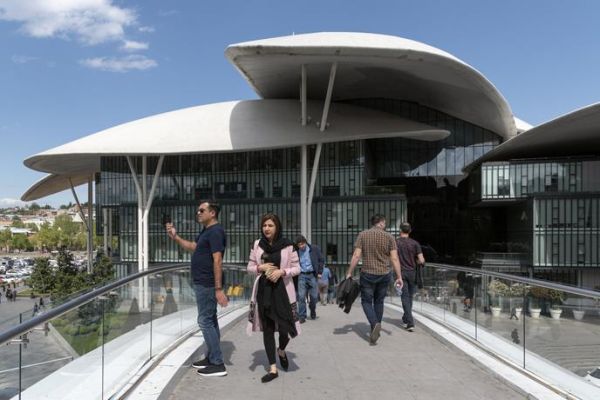 |
|
|
Public Service Hall, 2012,
Fuksas,
Photo
© Erik-Jan Ouwerkerk |
|
Urban development: 2000 until 2018 At the beginning of the new
millennium a private construction industry emerged that first
and oremost served the needs of the aspiring upper middle class,
but also initiated various projects hinging on property
speculation. Housing became investments that served profit
maximization.The predominant type of structure built as a result,
with the trend towards monumental edifices in Tbilisi, was
multi-purpose high-rise complexes, where offices, hotels,
fitness centers, casinos and clubs were all grouped together
under one roof, like in New York. The structures (Biltmore
Hotel, Axis Towers) were often over-sized and led to a reshaping
of the homogeneous cityscape. What is meant by New Style in
Georgia seems to be dictated by the capitalist world that is new
to the country; high-end residential complexes stretch to the
very limits of the land they are on. The multi-purpose
“Rustaveli Residence” in downtown Tbilisi, which was
commissioned in 2012, and recent Chinese construction projects
such as “Hualing. Tbilisi Sea New City” demonstrate interest
global players have in investing here. As does the Museum of
Fine Arts, which serves as an exhibition venue, lifestyle center,
and hotel at one and the same time, a hybrid cultural machine,
which unites art and commerce.
|
|
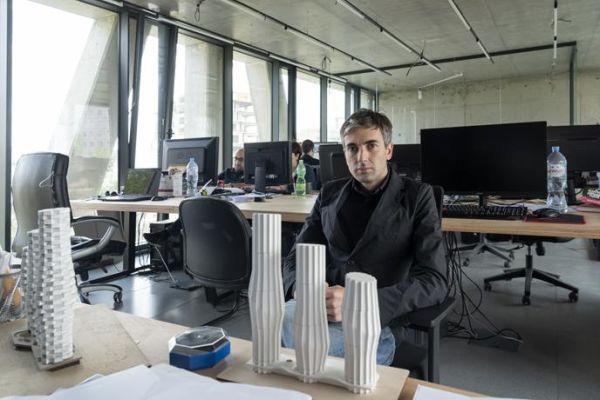 |
| |
Giorgi Khmaladze represents the next generation of
internationally-studied architects with the three-tower project
Alliance and Wyndham, Photo
© Erik-Jan Ouwerkerk
|
Refurbishment of the old town: 2011-12 At the suggestion of the
national ICOMOS committee, in 1999 Georgia proposed that the old
town of Tbilisi be inscribed on the UNESCO World Cultural
Heritage List in a drive to generate global interest in the fate
of the city. The old town dates from the 19th century. Narrow
alleys, buildings with open verandas and beautifully carved
wooden balconies, not to mention a number of old edifices, make
for a picturesque sight. Old buildings hang like grapes from the
cliffs above River Kura (Mtkvari). Initial restoration of the
old town took place in the late 1970s and embraced Baratashvili
Street and the surroundings. The project received strong public
funding. The second stage from 2011-2 under President
Saakashvili saw the elaborate comprehensive renovation of the
Kala district and Abanotubani. Entire districts (Marjanishvili)
and boulevards (Aghmashenebeli Avenue) dating from the 19th
century were radically recreated with replicas of historical
buildings and a focus on facades. As of 2012, the new government
initially continued the trend, but of late a change would appear
to be looming. Much of what survived and accounted for the
unique flair is now falling victim to gentrification or
unprofessional restoration. The next generation Hybrid Tbilisi
introduces a new generation of Georgian architects and designers
and as examples presents four positions: Nikoloz Sebiskveradze
and Dimitri Elikashvili from Sebo & Dito Studio, Nikoloz
Japaridze from Architects of Invention, Giorgi Khmaladze
Architects, as well as Nata Janberidze and Keti Toloraia from
Rooms. They studied at the Tbilisi Art Academy, at Delft, Paris,
and Harvard Universities, and did a doctorate in Moscow. Despite
their young age these architects and designers have long since
been internationally renowned. Their buildings are defined by
diverse influences. Their spaces combine a 1930s western
atmosphere with the charm of old Tbilisi. And not least of all,
their interiors represent a “Georgian” blend of Asian and
European elements – indeed, Hybrid Tbilisi.
ENRICHING BOOKS AND BUILDINGS: NEW PUBLICATIONS ON ARCHITECTURE
IN GEORGIA
Symposium with DOM publishers
Philipp Meuser, Architekt BDA, Verleger DOM publishers
Parochialkirche, Klosterstraße 67, 10179 Berlin-Mitte
Fri, October 19, 2018, 6 – 9 p.m.
GEORGIAN FILM EVENING
Film 1: “Full speed westward. Georgia in search of its future” \
Director: Stefan Tolz, (2013, 90 Min)
Film 2: “When the Earth Seems to be Light” \ Directors: S.
Machaidze, T. Karumidze, D. Meskhi (2016, 44 Min.
Film 3: “Pirimze” \ Director: Sophia Tabatadze (2015, 39
Min.)Moderator: IRINA KURTISHVILI, Curator of the exhibition
HYBRID TBILISI
DAM Auditorium, 5 € \ 2,50 € reduced
Tue, October 23, 2018, 7 p.m.
GEORGIAN ARCHITECTURE EVENING
GIORGI KHMALADZE, Khmaladze Architects, Tbilisi
THOMAS WILLEMEIT, GRAFT Architects, Berlin
Moderator: PETER CACHOLA SCHMAL
DAM Auditorium, 5 € \ 2,50 € reduced
Tue, October 2, 2018, 8 p.m.
FILM EVENING IN COOPERATION WITH ALLERWELTSKINO E.V. KÖLN
Film: 2+2=22 (The Alphabet), Director: Heinz Emigholz (2013, 88
Min.)
Moderator: JOACHIM STEINIGEWEG, Allerweltskino e.V & IRINA
KURTISHVILI, Curator of the exhibition HYBRID TBILISI
Off Broadway Filmtheater, Zülpicherstr. 24, 50674 Köln \ 6€
Thu, December 6, 2018, 7 p.m.
DAM AS GUEST AT UAA
PETER CACHOLA SCHMAL, Director DAM & IRINA KURTISHVILI, curator
Moderator: SOPHIA UNGERS
Admission free, UAA Ungers Archiv für Architekturwissenschaft,
Belvederestr. 60, 50933 Cologne
Thu, November 8, 2018, 7 – 9 p.m.
POST-SOVIET LIFESTYLES?
Art, Fashion, Music, Architecture and Design from contemporary
Georgia
Moderator: MAHRET IFEOMA KUPKA, curator of the exhibition „Lara
protects me. A Georgian Story“ (Museum Angewandte Kunst)
Museum Angewandte Kunst, Schaumainkai 17, Frankfurt am Main, 5 €
\ 3,50 € reduced
PUBLICATION
Hybrid Tbilisi
Ed. Peter Cachola Schmal, Irina Kurtishvili DOM Publishers
264 pages, German/English, 2018. A Georgian translation of all
essays is enclosed.
IMPRINT
Hybrid Tbilisi
Reflections on Architecture in Georgia
September 29, 2018 – January 13, 2019
An exhibition by Deutsches Architekturmuseums (DAM)
in behalf of the Department of Culture and Science / Culture
Board, City of Frankfurt am Main
|
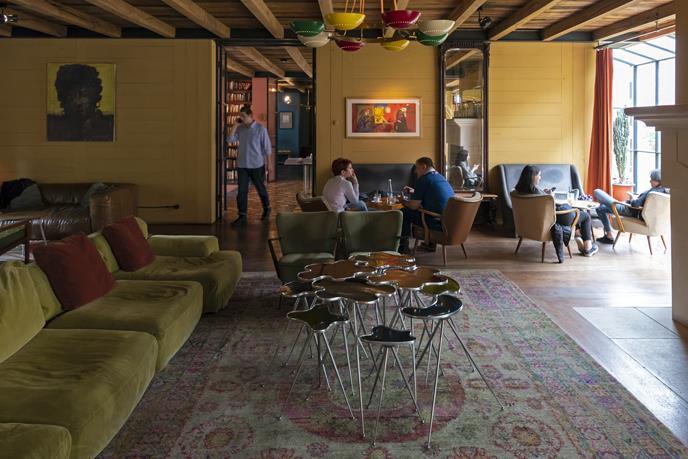 |
|
|
Newest concept
hotel Rooms Hotel Tbilisi, opened in 2012,
Photo
© Erik-Jan Ouwerkerk
|
|
Director Peter Cachola Schmal Deputy Director Andrea Jürges
Curators Peter Cachola Schmal, Irina Kurtishvili Exhibition
Design Mario Lorenz, Laura Risse, Katrin Mueller – Deserve,
Wiesbaden Press and Public Relations Brita Köhler, Rebekka Rass
Education Curator Christina Budde with Bettina Gebhardt, Arne
Winkelmann Registrar Wolfgang Welker Head of Archives Inge Wolf
Library Christiane Eulig Director’s Office Inka Plechaty
Administration Jacqueline Brauer Installation Team Marina Barry,
Paolo Brunino, Ulrich Diekmann, Enrico Hirsekorn, Caroline
Krause, Ömer Simsek, Beate Voigt, Gerhard Winkler under the
direction of Christian Walter Museum Technician Joachim
Müller-Rahn Printing of the Exhibition Panels inditec GmbH, Bad
Camberg Translations Jeremy Gaines (German, English), Tamuna
Gurtschiani (Georgian) Editing Wolfgang Till Busse (German), Tea
Tvalavadze (Georgian) Photographers i.a. Erik-Jan Ouwerkerk,
Mario Lorenz, Peter Cachola Schmal, Sandro Sulaberidze, Irina
Kurtishvili, Jesko Johnnson-Zahn, Achim Riechers, Guram
Kapanadze, Marcus Buck, Tobias Hein, Louisa Chalatashvili,
Dimitri Kavtaradze Guided Tours Yorck Förster Archives